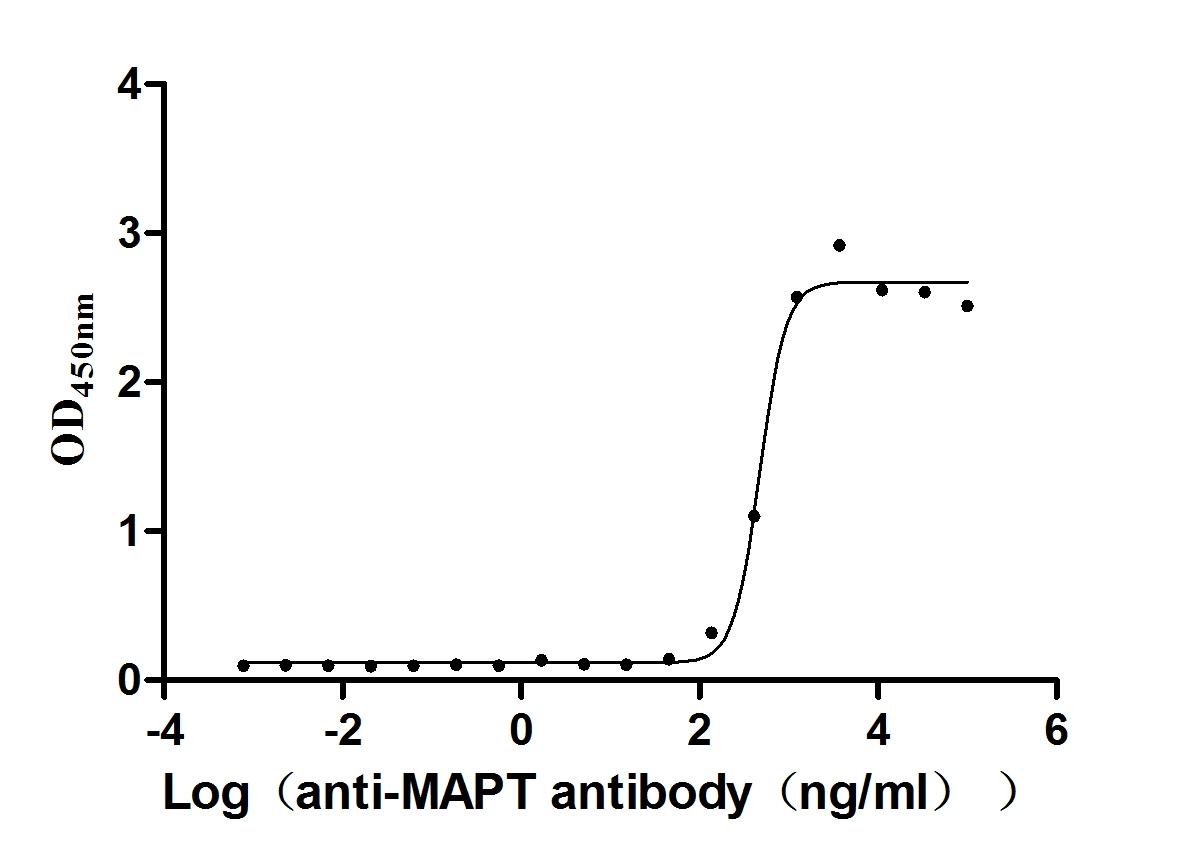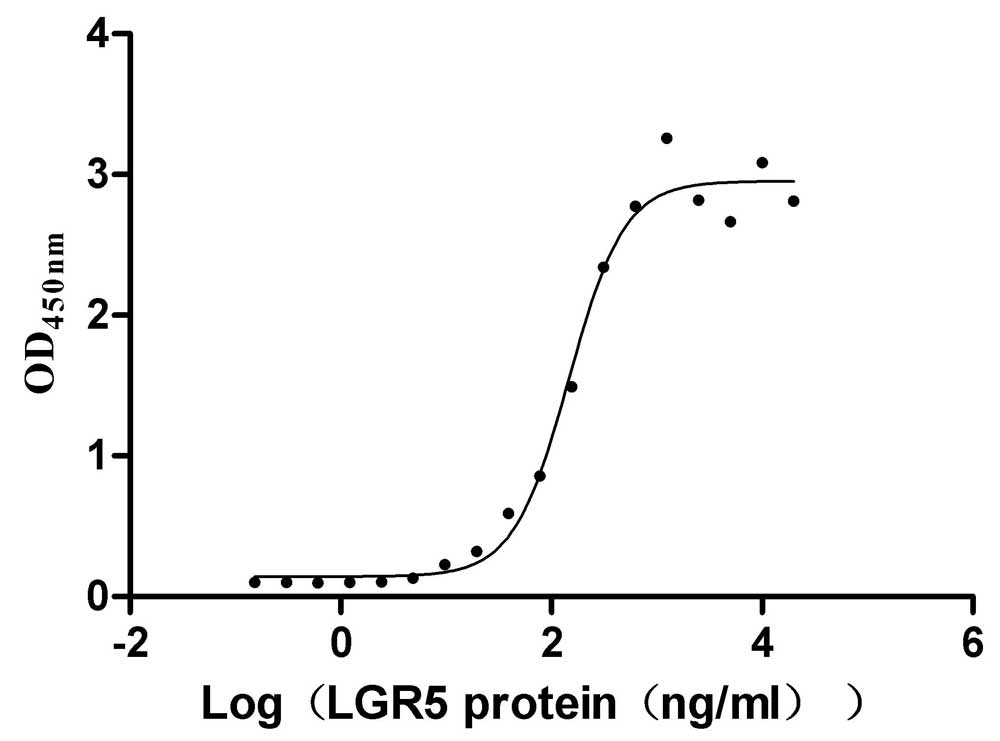Recombinant Human Nuclear factor erythroid 2-related factor 1 (NFE2L1), partial
-
货号:CSB-YP614530HU
-
规格:
-
来源:Yeast
-
其他:
-
货号:CSB-EP614530HU
-
规格:
-
来源:E.coli
-
其他:
-
货号:CSB-EP614530HU-B
-
规格:
-
来源:E.coli
-
共轭:Avi-tag Biotinylated
E. coli biotin ligase (BirA) is highly specific in covalently attaching biotin to the 15 amino acid AviTag peptide. This recombinant protein was biotinylated in vivo by AviTag-BirA technology, which method is BriA catalyzes amide linkage between the biotin and the specific lysine of the AviTag.
-
其他:
-
货号:CSB-BP614530HU
-
规格:
-
来源:Baculovirus
-
其他:
-
货号:CSB-MP614530HU
-
规格:
-
来源:Mammalian cell
-
其他:
产品详情
-
纯度:>85% (SDS-PAGE)
-
基因名:NFE2L1
-
Uniprot No.:
-
别名:erythroid derived 2; like 1; Locus control region factor 1 ; Locus control region-factor 1; NF-E2-related factor 1; NF2L1_HUMAN; NFE2 related factor 1; NFE2-related factor 1; NFE2L1; NRF1; Nuclear factor; Nuclear Factor Erythroid 2 Related Factor 1; Nuclear factor erythroid 2-related factor 1; Nuclear factor erythroid derived 2 like 1; TCF-11; TCF11; Transcription factor 11; Transcription factor HBZ17; Transcription factor LCR F1; Transcription factor LCR-F1
-
种属:Homo sapiens (Human)
-
蛋白长度:Partial
-
蛋白标签:Tag type will be determined during the manufacturing process.
The tag type will be determined during production process. If you have specified tag type, please tell us and we will develop the specified tag preferentially. -
产品提供形式:Lyophilized powder
Note: We will preferentially ship the format that we have in stock, however, if you have any special requirement for the format, please remark your requirement when placing the order, we will prepare according to your demand. -
复溶:We recommend that this vial be briefly centrifuged prior to opening to bring the contents to the bottom. Please reconstitute protein in deionized sterile water to a concentration of 0.1-1.0 mg/mL.We recommend to add 5-50% of glycerol (final concentration) and aliquot for long-term storage at -20℃/-80℃. Our default final concentration of glycerol is 50%. Customers could use it as reference.
-
储存条件:Store at -20°C/-80°C upon receipt, aliquoting is necessary for mutiple use. Avoid repeated freeze-thaw cycles.
-
保质期:The shelf life is related to many factors, storage state, buffer ingredients, storage temperature and the stability of the protein itself.
Generally, the shelf life of liquid form is 6 months at -20°C/-80°C. The shelf life of lyophilized form is 12 months at -20°C/-80°C. -
货期:Delivery time may differ from different purchasing way or location, please kindly consult your local distributors for specific delivery time.Note: All of our proteins are default shipped with normal blue ice packs, if you request to ship with dry ice, please communicate with us in advance and extra fees will be charged.
-
注意事项:Repeated freezing and thawing is not recommended. Store working aliquots at 4°C for up to one week.
-
Datasheet :Please contact us to get it.
相关产品
靶点详情
-
功能:Endoplasmic reticulum membrane sensor that translocates into the nucleus in response to various stresses to act as a transcription factor. Constitutes a precursor of the transcription factor NRF1. Able to detect various cellular stresses, such as cholesterol excess, oxidative stress or proteasome inhibition. In response to stress, it is released from the endoplasmic reticulum membrane following cleavage by the protease DDI2 and translocates into the nucleus to form the transcription factor NRF1. Acts as a key sensor of cholesterol excess: in excess cholesterol conditions, the endoplasmic reticulum membrane form of the protein directly binds cholesterol via its CRAC motif, preventing cleavage and release of the transcription factor NRF1, thereby allowing expression of genes promoting cholesterol removal, such as CD36. Involved in proteasome homeostasis: in response to proteasome inhibition, it is released from the endoplasmic reticulum membrane, translocates to the nucleus and activates expression of genes encoding proteasome subunits.; CNC-type bZIP family transcription factor that translocates to the nucleus and regulates expression of target genes in response to various stresses. Heterodimerizes with small-Maf proteins (MAFF, MAFG or MAFK) and binds DNA motifs including the antioxidant response elements (AREs), which regulate expression of genes involved in oxidative stress response. Activates or represses expression of target genes, depending on the context. Plays a key role in cholesterol homeostasis by acting as a sensor of cholesterol excess: in low cholesterol conditions, translocates into the nucleus and represses expression of genes involved in defense against cholesterol excess, such as CD36. In excess cholesterol conditions, the endoplasmic reticulum membrane form of the protein directly binds cholesterol via its CRAC motif, preventing cleavage and release of the transcription factor NRF1, thereby allowing expression of genes promoting cholesterol removal. Critical for redox balance in response to oxidative stress: acts by binding the AREs motifs on promoters and mediating activation of oxidative stress response genes, such as GCLC, GCLM, GSS, MT1 and MT2. Plays an essential role during fetal liver hematopoiesis: probably has a protective function against oxidative stress and is involved in lipid homeostasis in the liver. Involved in proteasome homeostasis: in response to proteasome inhibition, mediates the 'bounce-back' of proteasome subunits by translocating into the nucleus and activating expression of genes encoding proteasome subunits. Also involved in regulating glucose flux. Together with CEBPB; represses expression of DSPP during odontoblast differentiation. In response to ascorbic acid induction, activates expression of SP7/Osterix in osteoblasts.
-
基因功能参考文献:
- Data show that Nrf1 can adopt several topologies within membranes that are determined by its NTD. PMID: 20629635
- Fbw7 as a regulator of Nrf1 expression and reveal a novel function of Fbw7 in cellular stress response. PMID: 21953459
- results indicate a novel role of Nrf1 in UVB-induced DNA damage repair and suggest Nrf1 as a tumor suppressor in the skin PMID: 22500024
- Data indicate both Nrf1a and Nrf1b isoforms transcripts were detected in different mouse and human cell lines, and in various mouse tissues. PMID: 23144760
- Nrf1 knockout resulted in the increased expression of GCLC and GCLM in human bronchial epithelial (HBE1) cells. PMID: 24024152
- while Nrf2 is crucial for MRE/ARE-mediated transcription in response to copper, Nrf1 may activate MT-1 expression by a mechanism different from that Nrf2 employs. PMID: 24462598
- Nrf1 physically interacts with androgen receptor and enhances it's DNA-binding activity, suggesting that the p65-Nrf1 isoform is a potential androgen receptor coactivator. PMID: 24466341
- The treatment with E2, Res, or VC significantly increased mRNA and protein expression levels of Nrf1. PMID: 25130429
- The results indicate that Nrf1 is a transcriptional activator of Herpud1 expression during ER stress, and they suggest Nrf1 is a key player in the regulation of the ER stress response in cells. PMID: 25637874
- This review outlines Nrf1 structure, function, regulation and its links to insulin resistance, diabetes and inflammation. PMID: 26254094
- Importantly, Nrf1 activity is positively and/or negatively regulated by distinct doses of proteasome and calpain inhibitors PMID: 26268886
- Together with molecular expression results, the s thus suppose requirement of Nrf1alpha (and major derivates) for gene regulatory mechanisms repressing cancer cell process and malignant behaviour. PMID: 27065079
- These results uncover a new regulatory mechanism that USP15 activates Nrf1 against the beta-TrCP inhibition to maintain proteostasis. PMID: 27416755
- Here the s show that the aspartyl protease DNA-damage inducible 1 homolog 2 (DDI2) is required to cleave and activate Nrf1. PMID: 27528193
- Nrf1 is regulated by O-GlcNAc transferase. PMID: 28625484
- our investigation shows that the ER membrane protein TCF11/Nrf1 is an essential component of the cellular stress response mechanism. In response to cytotoxic stress, TCF11/Nrf1 is retrotranslocated and transferred to the nucleus where it induces proteasome subunit expression via binding to the ARE region of the relevant promoter. PMID: 27345029
- Data uncover an unexpected role for p97 in activation of transcription factor Nrf1 by relocalizing it from the endoplasmic reticulum lumen to the cytosol. PMID: 24448410
- Nrf1 is negatively regulated by its O-GlcNAcylation status that depends on the glucose concentrations PMID: 26231763
- A proteasome inhibitor-stimulated Nrf1 protein-dependent compensatory increase in proteasome subunit gene expression reduces polycomb group protein level PMID: 22932898
- The study identifies casein kinase 2 as an NRF1-binding protein and finds that the knockdown of casein kinase 2 enhances the NRF1-dependent expression of the proteasome subunit genes. PMID: 23816881
- GSK3 regulates Nrf1 expression and cell survival function in response to stress activation. PMID: 23623971
- findings suggest that nuclear-related factor erythroid 2 transcription factor (Nrf1) may play a role in maintaining genomic integrity, and that Nrf1 dysregulation may induce tumorigenesis PMID: 22971132
- data suggests that Nrf1 is controlled by several post-translational mechanisms, including ubiquitination, proteolytic processing and proteasomal-mediated degradation as well as by its phosphorylation status PMID: 22216197
- Report that proteasome inhibition can be anticipated by TCF11-dependent activation of human proteasome gene expression, which in turn is controlled by a HRD1-p97-ERAD feedback circle. PMID: 20932482
- Data show that nuclear factor erythroid-derived 2-related factor 1 (Nrf1), but not the related Nrf2, is necessary for induced proteasome gene transcription in mouse embryonic fibroblasts. PMID: 20385086
- A nuclear export signal (NES) localised in the N-terminus of TCF11 is responsible for the active nuclear export of the protein. PMID: 12729924
- p65Nrf1 has the potential to play an important role in modulating the response to oxidative stress by functioning as a transdominant repressor of Nrf2-mediated activation of ARE-dependent gene transcription PMID: 17609210
显示更多
收起更多
-
亚细胞定位:[Endoplasmic reticulum membrane sensor NFE2L1]: Endoplasmic reticulum membrane; Single-pass type II membrane protein. Endoplasmic reticulum membrane; Single-pass type III membrane protein.; [Transcription factor NRF1]: Nucleus.
-
蛋白家族:BZIP family, CNC subfamily
-
数据库链接:
HGNC: 7781
OMIM: 163260
KEGG: hsa:4779
STRING: 9606.ENSP00000354855
UniGene: Hs.514284
Most popular with customers
-
Recombinant Macaca fascicularis Delta-like protein 3 (DLL3), partial (Active)
Express system: Mammalian cell
Species: Macaca fascicularis (Crab-eating macaque) (Cynomolgus monkey)
-
Recombinant Mouse Microtubule-associated protein tau (Mapt) (Active)
Express system: Mammalian cell
Species: Mus musculus (Mouse)
-
Recombinant Human R-spondin-1 (RSPO1), partial (Active)
Express system: Mammalian cell
Species: Homo sapiens (Human)
-
Recombinant Human Tissue factor pathway inhibitor (TFPI), partial (Active)
Express system: Mammalian cell
Species: Homo sapiens (Human)
-
Recombinant Human Claudin-6 (CLDN6)-VLPs (Active)
Express system: Mammalian cell
Species: Homo sapiens (Human)
-
Recombinant Human Claudin-4 (CLDN4)-VLPs (Active)
Express system: Mammalian cell
Species: Homo sapiens (Human)
-
Recombinant Macaca fascicularis CD44 antigen (CD44), partial (Active)
Express system: Mammalian cell
Species: Macaca fascicularis (Crab-eating macaque) (Cynomolgus monkey)
-
Recombinant Human Microtubule-associated protein tau (MAPT) (Active)
Express system: Mammalian cell
Species: Homo sapiens (Human)






-AC1.jpg)


-AC1.jpg)










